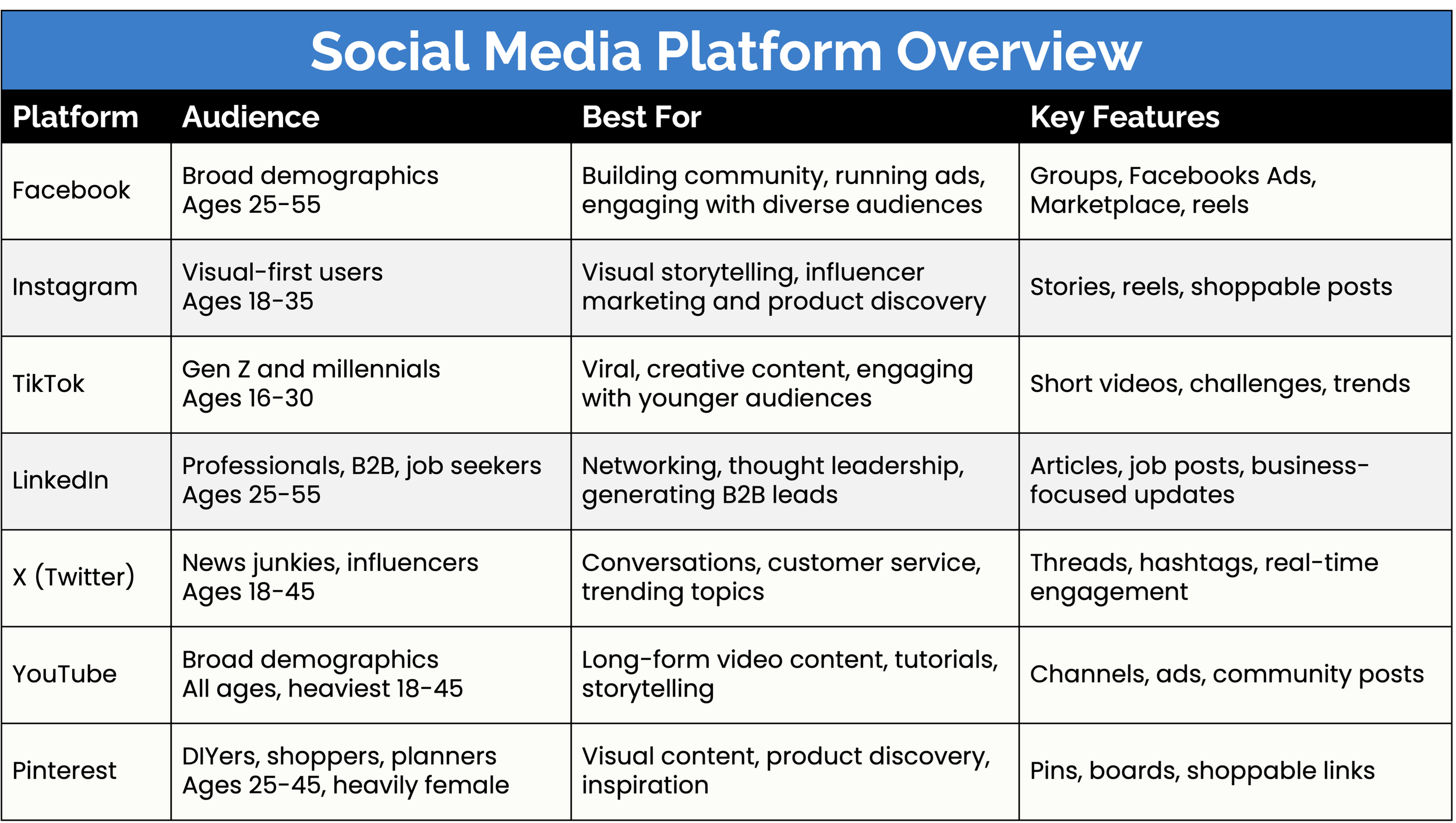Finding the Right Social Media Platforms for Your Business
Social media is a powerful tool for businesses, but not all platforms are created equal. With so many options—Facebook, Instagram, TikTok, LinkedIn, Twitter, Pinterest, and more—it can be overwhelming to decide where to focus your efforts. The key is to identify the platforms that align with your audience, your goals, and your content style.
Here’s a step-by-step guide to finding the right social media platforms for your business.
Step 1: Understand Your Target Audience
The first step is knowing who you’re trying to reach. Different platforms attract different demographics, interests, and behaviors. By understanding your audience, you can choose the platforms where they’re most active.
Questions to Ask:
What are their demographics? (age, gender, location, etc.)
What are their interests and behaviors online?
What problems are they trying to solve that your business can address?
Example: If your target audience is Gen Z, TikTok or Instagram might be your best bet. If you’re targeting professionals or B2B clients, LinkedIn could be more effective.
Step 2: Define Your Business Goals
Your social media strategy should align with your overall business objectives. The platform you choose will depend on what you’re trying to achieve.
Common Goals:
Increase Brand Awareness: Platforms with large, diverse audiences like Facebook and Instagram.
Generate Leads: LinkedIn for B2B, or Pinterest for product discovery.
Drive Sales: TikTok, Instagram, or Facebook with their strong e-commerce features.
Engage With Your Community: Twitter and Instagram for real-time interaction.
Showcase Expertise: LinkedIn and YouTube for thought leadership content.
Example: A local boutique may focus on Instagram to showcase products visually, while a SaaS company might prioritize LinkedIn to share white papers and generate leads.
Step 3: Evaluate Platform Demographics and Features
Each social media platform has its own strengths and weaknesses. Choosing the right one depends on matching its features and audience to your business needs.
Understand where your audience hangs out online and start there.
Step 4: Assess Your Content Capabilities
Your choice of platform should reflect the type of content you can consistently produce.
Visual Content (Photos, Videos): Instagram, TikTok, Pinterest, YouTube.
Text-Based Content (Thought Leadership, Articles): LinkedIn, Twitter.
Community Interaction (Groups, Conversations): Facebook, Twitter.
Tutorials and How-To Content: YouTube, Pinterest.
Example: If you don’t have the resources for high-quality videos, TikTok or YouTube might not be the best fit. However, if you excel in writing, LinkedIn or Twitter could be ideal.
Step 5: Start Small and Test
You don’t have to be everywhere at once. Start with one or two platforms, focus on building a strong presence, and expand as you gain traction.
Steps to Test Platforms:
Create a content calendar and post consistently.
Monitor engagement metrics like likes, shares, comments, and clicks.
Use platform analytics tools to see what’s working.
Example: A new bakery might start with Instagram to showcase its creations visually and then test Facebook to promote local events.
Step 6: Leverage Analytics and Feedback
Data doesn’t lie. Use analytics tools to measure your performance and adjust your strategy.
Metrics to Track:
Engagement Rate: Are people liking, sharing, or commenting on your content?
Follower Growth: Is your audience expanding?
Website Traffic: Are social posts driving traffic to your website?
Conversion Rate: Are your posts leading to sales or sign-ups?
Pro Tip: Pay attention to customer feedback. If people are asking questions or interacting more on one platform, it might be worth doubling down there.
Step 7: Stay Adaptable
Social media trends and algorithms change constantly. Stay informed about platform updates and be ready to pivot when necessary.
Example: If TikTok trends are dominating your industry, consider experimenting with short-form videos even if it’s not your primary platform.
Final Thoughts
Choosing the right social media platforms for your business is about quality, not quantity. It’s better to focus on a few platforms where your audience is active and engaged than to spread yourself too thin.
By understanding your audience, defining your goals, and evaluating your content capabilities, you can find the platforms that will give you the best ROI. And remember—social media is a dynamic space. Be ready to experiment, adapt, and grow.
Need help identifying the best social media platforms for your business? Contact us today to discuss our coaching sessions!

